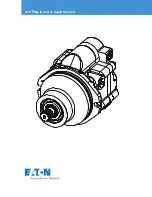
ENGLISH
5
BEFORE OPERATION CHECKS
IS YOUR ENGINE READY TO GO?
For your safety, to ensure compliance with environmental
regulations, and to maximize the service life of your equipment, it is
very important to take a few moments before you operate the
engine to check its condition. Be sure to take care of any problem
you find, or have your servicing dealer correct it, before you
operate the engine.
Before beginning your pre-operation checks, be sure the engine is
level and the engine switch is in the OFF position.
Always check the following items before you start the engine:
Check the General Condition of the Engine
1. Look around and underneath the engine for signs of oil or
gasoline leaks.
2. Remove any excessive dirt or debris, especially around the
muffler and recoil starter.
3. Look for signs of damage.
4. Check that all shields and covers are in place, and all nuts,
bolts, and screws are tightened.
Check the Engine
1. Check the fuel level (see page 8). Starting with a full tank will
help to eliminate or reduce operating interruptions for refueling.
2. Check the engine oil level (see page 9). Running the engine with
a low oil level can cause engine damage.
If the oil level in the crankcase falls below a safe limit, the Oil
Alert system will either shut off the engine or issue a warning.
However, to avoid the inconvenience of an unexpected
shutdown, always check the engine oil level before startup.
3. Check the air filter element (see page 10). A dirty air filter
element will restrict air flow to the carburetor, reducing engine
performance.
4. Check the equipment powered by this engine.
Review the instructions provided with the equipment powered
by this engine for any precautions and procedures that should
be followed before engine startup.
Improperly maintaining this engine, or failure to
correct a problem before operation, can cause a
malfunction in which you can be seriously hurt or
killed.
Always perform a pre-operation inspection before
each operation, and correct any problem.
OPERATION
SAFE OPERATING PRECAUTIONS
Before operating the engine for the first time, please review the
SAFETY INFORMATION
section on page 2 and the
BEFORE
OPERATION CHECKS
on this page.
For your safety, do not operate the engine in an enclosed area such
as a garage. Your engine’s exhaust contains poisonous carbon
monoxide gas that can collect rapidly in an enclosed area and
cause illness or death.
Review the instructions provided with the equipment powered by
this engine for any safety precautions that should be observed with
engine startup, shutdown, or operation.
STARTING THE ENGINE
WITH ELECTRIC STARTER:
1. Move the fuel valve lever to
the ON position.
2. Turn the engine switch to the
START position, and hold it
there until the engine starts.
Some engine applications do
not include the
engine-mounted control box
with engine switch shown
here. Refer to the instructions
provided by the equipment
manufacturer.
If the engine fails to start
within 5 seconds, release the
engine switch, and wait at
least 10 seconds before
operating the starter again.
Using the electric starter for
more than 5 seconds at a
time will overheat the starter
motor and can damage it.
When the engine starts,
release the engine switch,
allowing it to return to the ON
position.
Exhaust contains poisonous carbon monoxide gas
that can build up to dangerous levels in closed areas.
Breathing carbon monoxide can cause
unconsciousness or death.
Never run the engine in a closed, or even partly closed
area where people may be present.
FUEL VALVE LEVER
ON
ON
START
ENGINE SWITCH
37Z8R803.fm 5 ページ 2014年3月25日 火曜日 午後1時42分






































